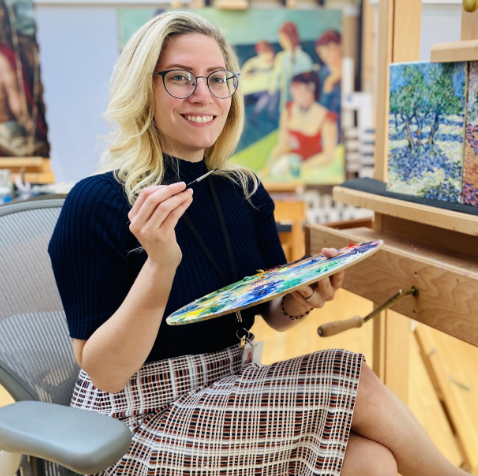An intricate marriage of art and science, art conservation involves researching and assessing the needs of the works of art, implementing preventative treatments, and repairing damaged or deteriorating objects.
Learn more about the ways the DMA cares for its collection of more than 25,000 objects.
DMA conservators care for hundreds of works each year, from paintings and decorative objects to works on paper. They also undertake major projects throughout the year.
One of the few visible conservation spaces in the world, the Inge-Lise Eckmann Lane Paintings Conservation Center is the DMA’s paintings conservation studio. The studio is located on the top floor of the South Concourse, serving as a center for the study and treatment of works of art.
The adjacent Conservation Gallery is also open to the public and is designed to teach visitors about key findings gleaned through conservation-related study and treatment.
Through this unique component of public access, visitors witness cutting-edge conservation techniques and interact with DMA conservators when projects are underway.
Here you’ll find answers to some of the most commonly asked questions about art conservation.
What is art conservation?
Works of art are made of organic materials that age and change over time. Pigments fade and materials become brittle, and pieces sometimes get dropped or broken. The role of the conservator, first and foremost, is to develop a deep understanding of the artist’s original intent for the piece and ensure that this crucial sense of meaning of the piece is altered as little as possible, if at all, in the process of maintaining it.
What is the most important thing about art conservation?
One of the golden guiding rules of modern art conservation is that anything conservators do to a work of art has to be reversible. For example, when a conservator adds something to a work of art to disguise damage, or glues a broken sculpture back together, the conservator must choose materials that can be replaced by another conservator, whether in 10 years or hundreds of years later. Only the artist’s original work should be permanent.
What is the difference between restoring and conserving?
Restoration and conservation are not interchangeable terms. Conservation is the profession devoted to the preservation of cultural property with all actions aimed at safeguarding collections. Restoration is the practice of attempting to return an object back to its original appearance or state. While elements of restoration can be used by trained conservators, it is a small aspect of modern conservation, which chooses methods with reversibility in mind.
How much time does it take to conserve a work of art?
Objects inevitably deteriorate, but our objective as preservers of material culture is to slow the rate of deterioration. The length of time it takes to “conserve” a work of art depends on the piece’s condition, the extent of damage, and/or the size. A minor treatment might take a day, but a major treatment could take years.
What happens when you touch a work of art?
While an object could accidentally break when touched or handled, another less obvious reason is that your fingers can leave behind invisible traces of oils, sweat and acids. This dirt and grime can cause damage over time by attracting debris, and it can also cause immediate, permanent damage to the surface. For example, paint layers can be cracked with surprisingly little pressure. Museums have a responsibility to balance the care of the object with public access so future generations have an opportunity to see it.
How can I become a conservator?
In addition to apprenticeships, most conservators now earn an advanced master's degree or beyond from a conservation or related graduate program.
How can I locate a conservator?
To find a conservator, please contact the American Institution for Conservation.
Will the DMA appraise a work of art for me?
DMA conservators do not provide appraisals. Below are some organizations that provide this service.
American Society of Appraisers
11107 Sunset Hills Road, Suite 310
Reston, VA 20190
703-478-2228 or 1-800-ASA-VALU
www.appraisers.org
Appraisers Association of America
212 West 35th Street, 11th Floor South
New York, NY 10001
212-889-5404
www.appraisersassoc.org
International Society of Appraisers
303 West Madison Street, Suite 2650
Chicago, IL 60606
312-981-6778
www.isa-appraisers.org

Fran Baas is the Object Conservator at the Dallas Museum of Art. She joined the DMA as the Associate Conservator of Objects in November 2013. As the leader of the Conservation Department, Baas works closely with Museum colleagues to integrate the activities of the conservation program across every area of the collection.
Baas has previously worked in conservation departments at the New Mexico Department of Cultural Affairs, the Barnes Foundation, and the Isabella Stewart Gardner Museum, among other institutions. Baas is a graduate of the SUNY Buffalo State College Master’s Program in Art Conservation, and she holds a master's in museum science from Texas Tech University.
Laura Eva Hartman is the Paintings Conservator at the Dallas Museum of Art. She joined the DMA to work alongside Mark Leonard in establishing the formal Paintings Conservation Department. Hartman undertakes the examination and treatment of paintings in the DMA’s collection, as well as loaned works for special exhibitions, working closely with colleagues in the Curatorial and Conservation departments. Notable projects include contributions to the Van Gogh and the Olive Groves exhibition and catalogue, and significant treatments for works in the DMA’s collection, including Jackson Pollock’s Cathedral, Louis Anquetin’s Woman at Her Toilette, and Rufino Tomayo’s Nude, to name a few. Hartman has published widely on the use of new and innovative treatment techniques developed at the DMA.
Hartman received her MS from the Winterthur/University of Delaware program in Art Conservation. She has held positions at institutions including the Museo Nacional del Prado in Madrid, Spain; the Mauritshuis Royal Picture Gallery in Den Haag, Netherlands; the Yale University Art Galleries in New Haven, Connecticut; and the Metropolitan Museum of Art in New York.

Beginning in 1984, the DMA maintained a small conservation studio devoted to the treatment of objects. The Museum’s paintings collection received consistent care and treatment from professional conservators in the North Texas region.
The DMA first began raising support to expand its conservation program in 2010, catalyzed by a generous gift from an anonymous donor. In 2012, Mark Leonard was appointed as Chief Conservator.
With Leonard’s arrival, plans were set in motion for design and construction of a new conservation facility. In November 2013, the DMA’s new Paintings Conservation Studio officially opened to the public, signaling the launch of a larger-scale, in-house conservation program. In October 2020, the studio was renamed in honor of Inge-Lise Eckmann Lane, a nationally recognized paintings conservator who was foundational to the growth of the DMA’s conservation program.